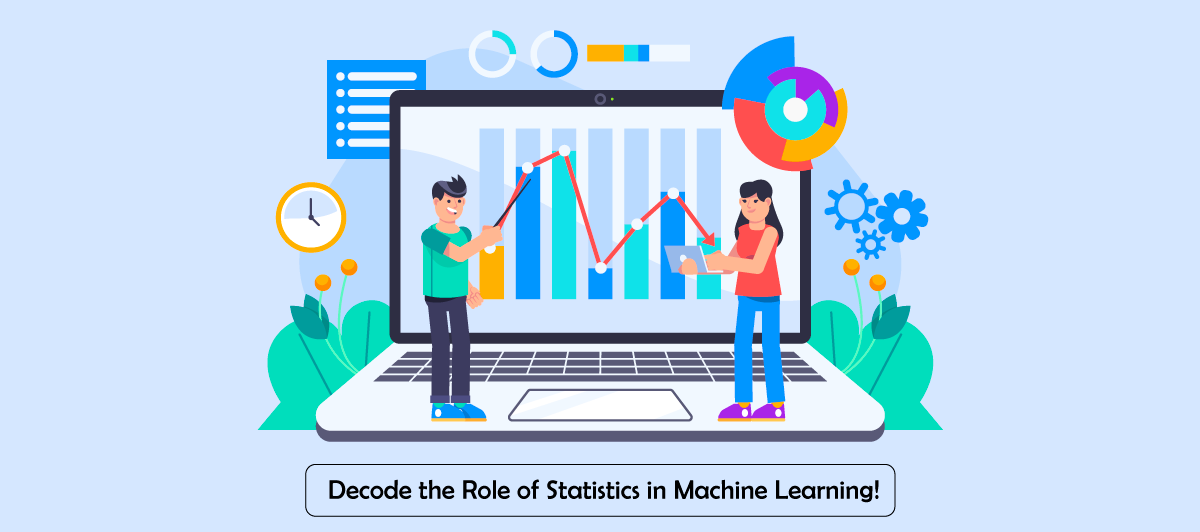How Statistics is used in Machine Learning?
Quick Summary: This article is about the important role of statistics in Machine Learning (ML). It emphasizes the point that both engineering and data science need to hold, exposing the usage of the statistical concepts in Machine learning for data analysis, modeling, and decision-making.
Introduction
The concept of machine learning, a branch of artificial intelligence, has greatly transformed the areas of technology that have never spared us a trend to make such a decision. On the other hand, in machine learning data analysis and mathematical techniques relied heavily on and statistics were being used at each process step.
Insta platform utilizes AI and big data on Instagram to implement its advertising, content optimization, audience analysis, and trend forecasting among other marketing tools, which elevates user engagement and quality of marketing strategies.Given this fact, this post will show you how statistics in machine learning operates which starts with data preprocessing and model evaluation at last, making these models reliable and precise enough.
What are statistics?
The statistic is one of the steps where we get some meaningful full information from raw ( junks ) data, performing some math or statistical analysis. It is easy to interpret information because of the techniques has been used to summarize information in a precise way and helps to make wise decisions on time.
Definition
Statistics is a branch of science that involves the collection, analysis, and data in large quantities So that you can come up with solving various use cases and conclusions and extract some meaningful full information that helps you in your prediction through ML modals. Whatever the type of the statistical data which is Descriptive or Inferential analyze it with the Test statistics calculator. This makes the data acquisition more realistic and reliable.
In statistics data is divided into two parts
- Descriptive
- Inferential
What is Descriptive?
Descriptive statistics comprehension the characteristics of a data set. Descriptive statistics hold two basic categories of measures: measures of central tendency and measures of variability. Measures of central tendency describe the central location of a data set. In this type of statistics, the information has been showcase in terms of graphs, charts, and table to make timely actions.
Inferential
An inferential statistic uses data from samples to generalize about a population. Furthermore, It takes statistics from the sample data and uses it to evaluate a population parameter (for example, the population mean).
Population
Generally, population refers to the people who live in a particular area for a specific time. But in statistics, population refers to data on your study of interest. It can be a group of individuals, objects, events, etc. You use populations to conclude.
For example, in the exit poll, it is not possible to gather all given votes before the election ends; the exit poll predicts this through the group of people. The same applies to sampling as well. Additionally, hire ML engineers to collaborate on applying statistical techniques for data analysis and modeling, enhancing decision-making through their expertise.
Sampling Techniques
The sampling data helps predict favors for all populations when we can’t get population data, so we get data from different fields’ opinions as data. Below, we highlighted some sampling techniques:
Random Sampling
- They randomly get selected quite well but hold some cons, like
- Overlapping
- For specific use-case, it won’t work
Stratified Sampling
- This sampling is used when you want to target those certain groups that indulge most. For example, beauty products were this kind of company targeting women. When we gather the data, we avoid unnecessary category
Systematic Sampling
- Systematic sampling is a probability sampling method in which a random sample with a fixed periodic interval is selected from a larger population.
- This method is efficient and more accessible to implement than simple random sampling in some cases.
Cluster Sampling
- In cluster sampling, samples are selected randomly from clusters of the population.
- It includes all the members of selected clusters.
Convenience Sampling
- Convenience sampling involves choosing the easiest or most readily available individuals or items for the sample.
- While quick and convenient, it can introduce bias and may not represent the population well.
Snowball Sampling
- Snowball sampling is helpful in situations where it’s challenging to determine all population members.
- It starts with an initial participant and relies on referrals to identify additional participants.
Purposive Sampling
- Purposive sampling involves selecting specific individuals or items intentionally based on certain characteristics.
- It is useful in qualitative research and may not be suitable for making generalizable inferences.
The measure of central tendency
Central Tendency is the summary of the data set that you calculate using Mean, Mode, and Median.
Let me show a few examples for all.
-
Mean:
- When the record holds values then mean is used. i.e. age = [ 33, 22, 55, 44, 55, 44 43] , mean = total age / number of records . 296 / 7 = 42.7
-
Median:
- This method is efficient when the record holds outliers like the following.
- For instance, age = [ 5, 4, 11, 15, 11, 9 90], where the average age is between 5-10 but because of 90 Mean value is 20.0
- which is not valid, Median get center value, for odd center value and for even add (two center value) /2 from center, and for odd take center Median = 15 from above example.
- This method is efficient when the record holds outliers like the following.
-
Mode:
- We have a record that contains several values extended, then we look for the one that repeats and take that as our mode. i. e. age = [2, 3, 5, 6, 7, 3, 3], Median = 3 .
Use of Statistical Methods in Machine Learning
Statistics is the base of crafting ML models. If there is not an accurate data depiction, it is impossible to using machine learning algorithms. It plays a crucial role in various aspects of data analytics and machine learning:
Data Preprocessing
- Statistical approaches give a hand to the management of missing data issues for data cleaning and also for detecting outliers.
- Descriptive statistics are useful in answering wide-ranging questions about data distribution.
Feature Engineering
- Statistical methods enable producing items from scratch or employing ones that are already available.
- The approaches like standardization and normalization maintain the characteristics on the same horizontal scale.
Model Training and Validation
- Statistical methods enable producing items from scratch or employing ones that are already available.
- The approaches like standardization and normalization maintain the characteristics on the same horizontal scale.
Model Evaluation
- Statistical methods enable producing items from scratch or employing ones that are already available.
- The approaches like standardization and normalization maintain the characteristics on the same horizontal scale.
Hypothesis Testing
- It considers whether the outcomes or the relationship of the variable and data are critical in the event that there will be statistics modifications.
- You may also have to use machine learning in order to analyze the impact of features importance or models amendment.
- It has been done with the methodical steps such as presuppose null hypothesis, assimilate sample data, compute testing of collected information, and takin an verdict whether to accept or refuse the null hypothesis.
Probability and Uncertainty
- Being necessary for Bayesian machine learning, achieving that is critical, since probabilistic models are then used to represent uncertainty.
- Bootstrapping is a tool, which allows us to consider models in a hypothesis context and define model parameters with respect to uncertainty.
- Probability theory has been used in machine learning to know the outcome of an event. Basically, it assists to make predictions.
Conclusion:
The stats is the key part in machine learning as it is the field that offers a mathematical basis for data analysis, training, and checking models. First, it assists businesses in understanding data distributions and consequently enables them to make appropriate decisions in terms of model examinations, performance assessment, and delivery of robust generalization. In this sense, statistics is the foundation of the algorithms engaged by machine learning.
FAQ
How does machine learning work?
Machine learning leverages techniques like algorithms and machine learning to scan data, recognize associations, and provides insights without explicitly programming the system. It is built out of a data set being modeled, developed and employed to forecast and to make decisions and so on.
How to use machine learning?
To use machine learning, one should collect and overhaul data inputs first. Then, after selecting a relevant algorithm, train it over your data then get it validated and finally deploy it for predictive or decision making purposes.
What does machine learning do?
The learning from the data is the key factor that allows computers to make decisions or predictions without need to program them. In the second place, it makes possible these complex operations like image recognition, recommendation systems, and fraud detection.
Why is machine learning so popular?
Machine learning is being applied in industries of all kinds, due to the fact that it can automate complex tasks, make the process of taking decisions much easier, and analyze huge amounts of data.
How to learn machine learning algorithms?
To begin machine learning algorithms learning, you should start with the basics (like math and statistics), then refer to topics of such types like supervised, unsupervised, and reinforcement, practice and work on the tasks using real data.





